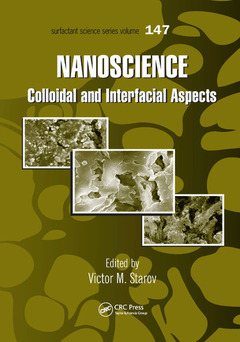Nanoscience Colloidal and Interfacial Aspects Surfactant Science Series
Coordonnateur : Starov Victor M.

The common perception is that nanoscience is something entirely new, that it sprung forth whole and fully formed like some mythological deity. But the truth is that like all things scientific, nanoscience is the natural result of the long evolution of scientific inquiry. Following a historical trail back to the middle of the 19th century, nanoscience is the inborn property of colloid and interface science. What?s important today is for us to recognize that nanoparticles are small colloidal objects. It should also be appreciated that over the past decades, a number of novel nanostructures have been developed, but whatever we call them, we cannot forget that their properties and behavior are still in the realm of colloid and interface science.
However one views it, the interest and funding in nano-science is a tremendous opportunity to advance critical research in colloid chemistry. Nanoscience: Colloidal and Interfacial Aspects brings together a prominent roster of 42 leading investigators and their teams, who detail the wide range of theoretical and experimental knowledge that can be successfully applied for investigating nanosystems, many of which are actually well-known colloidal systems.
This international grouping of pioneering investigators from academia and industry use these pages to provide researchers of today and tomorrow with a full examination of nano-disperse colloids, homogeneous and heterogeneous nano-structured materials (and their properties), and shelf-organization at the nano-scale. This cutting-edge reference provides information on investigations into non-linear electrokinetic phenomena in nano-sized dispersions and nano-sized biological systems. It discusses application aspects of technological processes in great detail, providing scientists and engineers across all fields with authoritative commentary on colloid and interface science operating at the nanoscale.
Nano-Science: Colloidal and Interfacial Aspects provides an authoritative resource for those wanting to familiarize themselves with current progress as well as for those looking to make their own impact on the development of new technologies and practical applications in fields as diverse as medicine, materials, and environmental science to name but a few. Whether you call the technology nano or colloids, the field continues to be ripe with opportunity.
Forces in Nanosystems. Surface Forces in Nanostructures. Effects of Nanoparticles on Forces between Colloids in Solution. Surface Forces and Nanoscale Phenomena in Aqueous Films Containing Nonionic Polymeric Surfactants. Quantification and Elucidation of the Overall Interaction Between Nanoparticles. Electrokinetic Phenomena on Nanoscale. Nonlinear Electrokinetic Phenomena in Nanosized Dispersions. Electroosmotic Flow in Micro- and Nanosized Systems. Electrokinetic Effects During the Langmuir–Blodgett Deposition Process. Electrosurface Characteristics of Oxide Nanolayers and Nanopore Membranes in Electrolyte Solutions. Transport in Fluidic Nanochannels. Ion Size Correlations in Electric Double Layers: Recent Computer Simulation Studies. Bio Nanosystems. Colloidal Chemical Properties of Biological Nanosystems: Biomembranes. Extracellular Biomineralization and Synthesis of Gold and Platinum Nano- and Microcrystals in Polysaccharide Aqueous Solutions. Lessons for Bionanointeractions from Colloidal Science. DNA–Surfactant Systems: Particles, Gels, and Nanostructures. Nanoemulsions. Interactions between Particles at a Fluid Interface. Recent Developments in Manufacturing Micro- and Nanoparticles from Emulsion Droplets. Behavior of Emulsions and Microemulsions—Implications for Nanosystems. Self-Organization on Nanoscale. Processes of Ultradisperse Structures Self-Organization During Electrochemical Dealloying. Colloid Chemical Processes of Contact Self-Organization in Alkaline Silicate Composites and Their Relation to Formation of Nanosized Surface Structures. Surfactant Self-Assembly at Interfaces and Its Relationship to Solution Self-Assembly: Studied by Small Angle Neutron Scattering and Neutron Reflectometry. Adsorption and Deposition of Particles, Polyelectrolytes, and Biopolymers. Monolayers and Multilayers: Equilibrium and Mechanical Properties. Formation of Nanocolloids. Rehbinder’s Effect, Spontaneous Dispergation Processes, and Formation of Nanosystems. Polymer Colloids. Aqueous Dispersions of Metallic Nanoparticles: Preparation, Stabilization, and Application. Novel Inorganic and Metal Nanoparticles Prepared by Inverse Microemulsion. Capillary Phenomena on Nanoscale. Wetting Phenomena and Nanoforces. Recent Progress on Nanofluids and Their Potential Applications. Wetting Phenomena Inside Carbon Nanotubes. Molecular Simulations for Nanofluids. Coagulation/Stability in Nanosystems. Physicochemical Microhydrodynamics of Ultradisperse Systems. Application of Coherent Fourier Spectroscopy for Diagnostics of Nanocrystalline Metals, Alloys, and Semiconductors. Stabilization of Dispersed Systems (in Particular Nanoparticles) by Polymers. Sedimentation of Bentonite Colloidal Suspensions under the Effect of aWeak Magnetic Field. Evaluation of the Mechanical and Tribological Properties of Self-Assembled Surfactant Nanostructures Using Atomic Force Microscopy. The Influence of Nanobubbles on Colloid Stability. Applications of Nanocolloids. Role of Nanostructures in the Process of Water Treatment by Coagulation. The Role of Nanotechnologies in Home and Personal Care Products. Concentrated Phases of Colloids or Nanoparticles: Solid Pressure and Dynamics of Concentration Processes. Catalytic Nanoclusters of Palladium on the Surface of Polypropylene Hollow Fiber Membranes: Removal of Dissolved Oxygen from Water.
Date de parution : 12-2017
17.8x25.4 cm
Date de parution : 07-2010
17.8x25.4 cm
Thèmes de Nanoscience :
Mots-clés :
Electroosmotic Dewatering; SPG; Forces in Nanosystems; Disjoining Pressure Isotherms; Electrokinetic Phenomena on Nanoscale; American Chemical Society; Bio Nanosystems; Disjoining Pressure; Self-Organization on Nanoscale; Electroosmotic Flow; Coagulation/Stability in Nanosystems; Contact Angle; colloidal systems; Contact Line; environmental science; Hamaker Constant; nanoscience; Equilibrium Contact Angle; self-organization; Latex Particles; nano-sized dispersions; PB Equation; Adsorbed Layer; Steric Repulsion; Self-assembled Surfactant; SPG Membrane; Lb Film; Mol Dm; Colloids Surf; DNA Condensation; Double Layer Overlap; Electrokinetic Potential; Wetting Films; Divalent Counterions; Surface Charge Density



